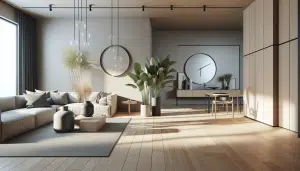Interior Design Ideas That Maximize Space
Lily Carter August 20, 2025
In 2025, space‑smart interior design ideas have become essential for smaller, more efficient homes. This guide explores emerging trends, practical tips, and expert-backed strategies that make the most of every square foot.

As urban living spaces shrink and housing prices soar, the demand for interior design ideas that maximize space has become more urgent than ever. In 2025, space optimization isn’t just about storage hacks—it’s about blending design, technology, and sustainability into smart, functional homes.
Why Maximizing Space Is Now Essential
Global real estate trends show that average apartment sizes are decreasing in most major cities. For example, U.S. new-build apartments have dropped from an average of 941 sq. ft in 2012 to around 887 sq. ft in 2022 (RentCafe 2022). With compact living becoming the norm, homeowners and renters alike are looking for ways to create comfort, functionality, and beauty in limited square footage.
2025’s Emerging Trends in Space-Saving Interior Design
1. Multifunctional Furniture Goes Mainstream
Furniture that performs multiple roles has moved from niche innovation to mainstream expectation. Think:
- Murphy beds that transform into desks.
- Sofas with hidden storage compartments.
- Dining tables that fold into wall-mounted shelves.
A report by The Global Furniture Market shows that demand for multifunctional furniture is projected to grow by 6.5% annually through 2027, driven by urbanization and smaller household sizes (Mordor Intelligence 2023).
2. AI-Powered Smart Storage
Smart homes aren’t just about voice assistants anymore. In 2025, AI-driven storage systems can automatically organize belongings and even suggest decluttering schedules. Companies like IKEA and Samsung have begun exploring AI-integrated modular units that adjust shelving heights and compartments based on real-time user needs.
3. Vertical Living and “Fourth-Dimensional” Design
Designers are embracing verticality—transforming walls and ceilings into usable storage and functional elements. Floating shelves, ceiling-mounted racks, and modular wall panels are now standard in micro-apartments. According to Architectural Digest, vertical solutions can free up to 30% of floor space in small homes (Architectural Digest 2023).
4. Hidden & Modular Kitchens
Tiny homes and apartments are fueling the popularity of modular kitchens that can be concealed when not in use. Slide-out counters, retractable stovetops, and hidden pantries are redefining how we perceive kitchen design.
5. Sustainable Space Maximization
Eco-conscious living aligns with smart design. Upcycling and modular, recyclable furniture not only save space but also reduce environmental impact. This trend resonates with younger homeowners who prioritize both efficiency and sustainability.
Practical Guide: Space-Saving Interior Design Ideas for Every Room
Living in smaller spaces doesn’t mean sacrificing style or functionality. With strategic design choices and clever storage solutions, you can maximize every square foot while creating a home that feels spacious, organized, and inviting. This comprehensive guide explores room-by-room strategies to help you make the most of your space, regardless of size.
Living Room: The Social Hub
The living room serves as the heart of your home, where family gathers and guests are entertained. Making this space both comfortable and efficient requires thoughtful furniture selection and creative storage solutions.
Multi-Functional Seating Solutions Use sofa-beds for overnight guests while maintaining daily comfort. Modern sofa-beds have evolved far beyond the uncomfortable pull-outs of the past, offering quality mattresses and stylish designs that work seamlessly in contemporary living spaces. Look for models with easy-to-operate mechanisms and sturdy frames that can handle regular use.
Invest in ottomans with built-in storage to serve triple duty as extra seating, footrests, and hidden storage for blankets, games, or seasonal items. Choose ottomans that complement your existing furniture and can be easily moved around the room as needed. Some models even feature removable tops that can double as serving trays.
Smart Entertainment Solutions Opt for wall-mounted media centers instead of bulky TV stands to free up valuable floor space and create a cleaner, more streamlined look. Wall-mounted units can be customized to fit your specific entertainment needs, with compartments for gaming consoles, streaming devices, and media storage. This approach also makes cleaning easier and can help prevent the accumulation of dust and clutter.
Vertical Storage Strategies Maximize wall space with floor-to-ceiling shelving units that draw the eye upward and make rooms feel taller. Use a mix of open shelving for display items and closed storage for items you want to keep hidden. Consider floating shelves in corners and awkward spaces that might otherwise go unused.
Lighting for Spaciousness Replace table lamps with wall-mounted sconces or pendant lights to free up surface space on side tables and create better task lighting. Use mirrors strategically to reflect light and create the illusion of more space.
Bedroom: Compact Comfort
The bedroom should be a peaceful retreat that maximizes rest while minimizing clutter. Smart storage and space-saving furniture choices are essential for creating a serene environment.
Innovative Bed Solutions Choose platform beds with drawers to eliminate the need for a separate dresser or provide additional storage for linens, seasonal clothing, or personal items. Platform beds with built-in storage can hold everything from extra bedding to out-of-season clothes, making them ideal for smaller bedrooms where every inch counts.
Install floating nightstands to open floor space and create a lighter, more airy feel in the bedroom. Floating nightstands also make cleaning easier and can be positioned at the perfect height for your mattress. Look for models with drawers or small compartments to keep bedside essentials organized.
Use foldable desks for hybrid work setups that can disappear when not needed. Wall-mounted drop-leaf desks or Murphy desk systems allow you to create a dedicated workspace that folds away completely when it’s time to sleep. This is particularly valuable in studio apartments or bedrooms that must serve multiple functions.
Closet Optimization Maximize closet space with double-hang rods, shelf dividers, and over-the-door organizers. Use slim hangers to fit more clothes in the same space, and consider seasonal clothing rotation to keep frequently used items accessible.
Under-Bed Storage Utilize the space under your bed with rolling storage containers, vacuum-sealed bags for seasonal items, or specially designed under-bed drawers. This often-overlooked space can hold shoes, linens, or clothing while remaining completely out of sight.
Kitchen: The Functional Core
The kitchen requires careful planning to balance functionality with space efficiency. Every cabinet, drawer, and surface should serve a purpose while maintaining an organized, clutter-free appearance.
Pantry and Storage Innovation Adopt pull-out pantry systems that make every item visible and accessible while maximizing deep cabinet space. Pull-out shelves prevent items from getting lost in the back of cabinets and make inventory management much easier. Consider installing pull-out systems in lower cabinets for pots, pans, and small appliances.
Install magnetic wall racks for utensils, knives, and small metal containers to free up valuable drawer space. Magnetic strips can hold everything from chef’s knives to spice containers, keeping frequently used items within easy reach while maintaining a clean countertop appearance.
Flexible Island Solutions Consider rolling islands that double as prep stations and dining tables, providing extra counter space when cooking and a casual dining area when entertaining. Choose models with storage underneath for dishes, cookbooks, or small appliances. Rolling islands can be moved out of the way when not needed or repositioned to accommodate different activities.
Vertical Kitchen Storage Make use of wall space with pot racks, open shelving for frequently used dishes, and hanging storage for everything from mugs to measuring cups. Install hooks inside cabinet doors for measuring spoons, oven mitts, and other small items.
Appliance Management Choose compact, multi-functional appliances that can perform several tasks, reducing the need for multiple single-purpose devices. Consider appliance garages or designated cabinets to keep countertops clear while maintaining easy access to frequently used items.
Bathroom: The Forgotten Small Space
Bathrooms are often the smallest rooms in the home, making efficient storage and space planning crucial for functionality and comfort.
Hidden Storage Solutions Use mirror cabinets for hidden storage of toiletries, medications, and personal care items while maintaining a clean, uncluttered appearance. Modern mirror cabinets come in various sizes and can be recessed into walls for a seamless look that doesn’t protrude into the room.
Install corner shelving units to take advantage of often-unused corner space for towels, decorative items, or frequently used products. Corner shelves can be particularly effective in shower areas for shampoo, soap, and other bathing essentials.
Space-Saving Door Solutions Replace swinging doors with sliding pocket doors to reclaim the floor space typically required for door clearance. Pocket doors slide into the wall cavity, making them ideal for tight spaces where a traditional door might interfere with fixtures or furniture placement.
Over-Toilet Storage Install over-toilet cabinets or shelving to utilize this often-wasted vertical space for storing extra toilet paper, towels, and cleaning supplies. Choose enclosed storage to maintain a tidy appearance.
Shower and Tub Organization Use shower caddies, built-in niches, or corner shelves to keep bathing products organized and easily accessible without cluttering tub edges or taking up floor space.
Entryway: First Impressions Matter
The entryway sets the tone for your entire home and requires careful organization to prevent clutter from accumulating and spreading to other areas.
Seating with Storage Add bench storage for shoes, bags, and seasonal accessories while providing a convenient place to sit when putting on or removing footwear. Choose benches with lift-up seats or built-in cubbies to maximize storage potential. Consider benches with baskets or bins underneath for easy organization and access.
Vertical Organization Systems Use wall hooks and vertical racks to keep clutter off the floor and create designated spots for coats, bags, keys, and other daily essentials. Install hooks at various heights to accommodate different family members and types of items. Consider a combination of hooks, small shelves, and mail organizers to create a complete command center.
Shoe Storage Solutions Implement shoe storage that works for your family’s lifestyle, whether that’s cubbies, over-the-door organizers, or a designated shoe cabinet. Keep frequently used shoes easily accessible while storing seasonal or special occasion footwear elsewhere.
Key and Mail Management Create a designated spot for keys, mail, and other small items that tend to accumulate in entryways. A small shelf with a decorative bowl or a wall-mounted organizer with compartments can prevent these items from cluttering surfaces throughout your home.
Universal Space-Saving Principles
Regardless of which room you’re organizing, certain principles apply across all spaces:
- Choose furniture that serves multiple purposes whenever possible
- Think vertically and use wall space effectively
- Keep frequently used items easily accessible while storing occasional-use items out of the way
- Maintain clear pathways and sightlines to preserve the feeling of spaciousness
- Use light colors and mirrors to enhance the sense of space
- Regular decluttering is essential to prevent accumulation of unnecessary items
By implementing these strategies room by room, you can create a home that feels spacious, organized, and perfectly suited to your lifestyle, regardless of its actual square footage.
Future Outlook: Where Space Design Is Heading
Looking ahead, three major developments will define the next decade:
- AI-Integrated Homes – Predictive design that adjusts storage layouts automatically.
- Augmented Reality Planning – AR tools that let users preview how multifunctional furniture fits before purchase.
- Circular Design Economy – Modular furniture designed for easy repair and recycling, ensuring sustainability.
Conclusion
Interior design ideas that maximize space are no longer optional—they’re a necessity. From multifunctional furniture to AI-powered solutions, the trend is toward smarter, more sustainable, and highly personalized living spaces. Whether you’re in a studio apartment in New York or a compact flat in Tokyo, the future of home design lies in making every square inch count.
References
American Society of Interior Designers (2022) Space Planning in Small Homes: Expert Design Strategies. Available at: https://www.asid.org/resources/space-planning-small-homes (Accessed: 20 August 2025).
Houzz Editorial Team (2023) 10 Clever Interior Design Hacks to Maximize Small Spaces. Available at: https://www.houzz.com/magazine/interior-design-hacks-small-spaces-stsetivw-vs~123456789 (Accessed: 20 August 2025).
Elle Decor (2021) Maximizing Space: Interior Design Ideas for Small Apartments. Available at: https://www.elledecor.com/design-decorate/small-space-ideas (Accessed: 20 August 2025).







